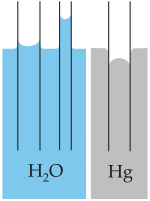
Photo from wikipedia
Abstract The formation of liquid bridge is pertinent to many fields including seepage into underground fractured rocks as an environmental issue and capillary continuity between matrix blocks which controls oil… Click to show full abstract
Abstract The formation of liquid bridge is pertinent to many fields including seepage into underground fractured rocks as an environmental issue and capillary continuity between matrix blocks which controls oil recovery in fractured reservoirs. Evaporation from the surface of liquid bridge into the surrounding gas could affect the stability of liquid bridge and fracture capillary pressure, which is not well discussed in the available literatures. In this research, by the aid of analogy between the diffusive flux and electrostatic potential, a new model for predicting evaporation rate from a liquid bridge inside a horizontal fracture is presented. The proposed model is then coupled with Young-Laplace equation to evaluate volume, shape and capillary pressure of liquid bridge as evaporation proceeds. Close agreement (R2 = 0.994) observed between model predictions and experimental data of evaporating liquid bridge, confirms reliability of the assumptions and the methodology made in model development. For the first time the impact of presence of solid substrate on evaporation rate as a function of liquid bridge volume, length and contact angle is described by a new mathematical expression. It has been found that transient behavior of fracture capillary pressure for a more realistic mode of evaporating liquid bridge, in which both contact angle and contact line change, indicates an initial increase, reaching to a maximum value, and finally a sharp decrease before rupture of bridge. In some cases, the capillary pressure of evaporating liquid bridge might reach to twice/half of its initial value. For liquid bridges with sufficient initial volume in thin fractures, stability period is prolonged and fracture capillary pressure values are greater, resulting a higher degree of capillary continuity. Results of this work help to better understand the gas-liquid transport in fractured porous media incorporating mass transfer between liquid bridge and surrounding gas for possible application in simulation models.
Journal Title: Journal of Petroleum Science and Engineering
Year Published: 2021
Link to full text (if available)
Share on Social Media: Sign Up to like & get
recommendations!